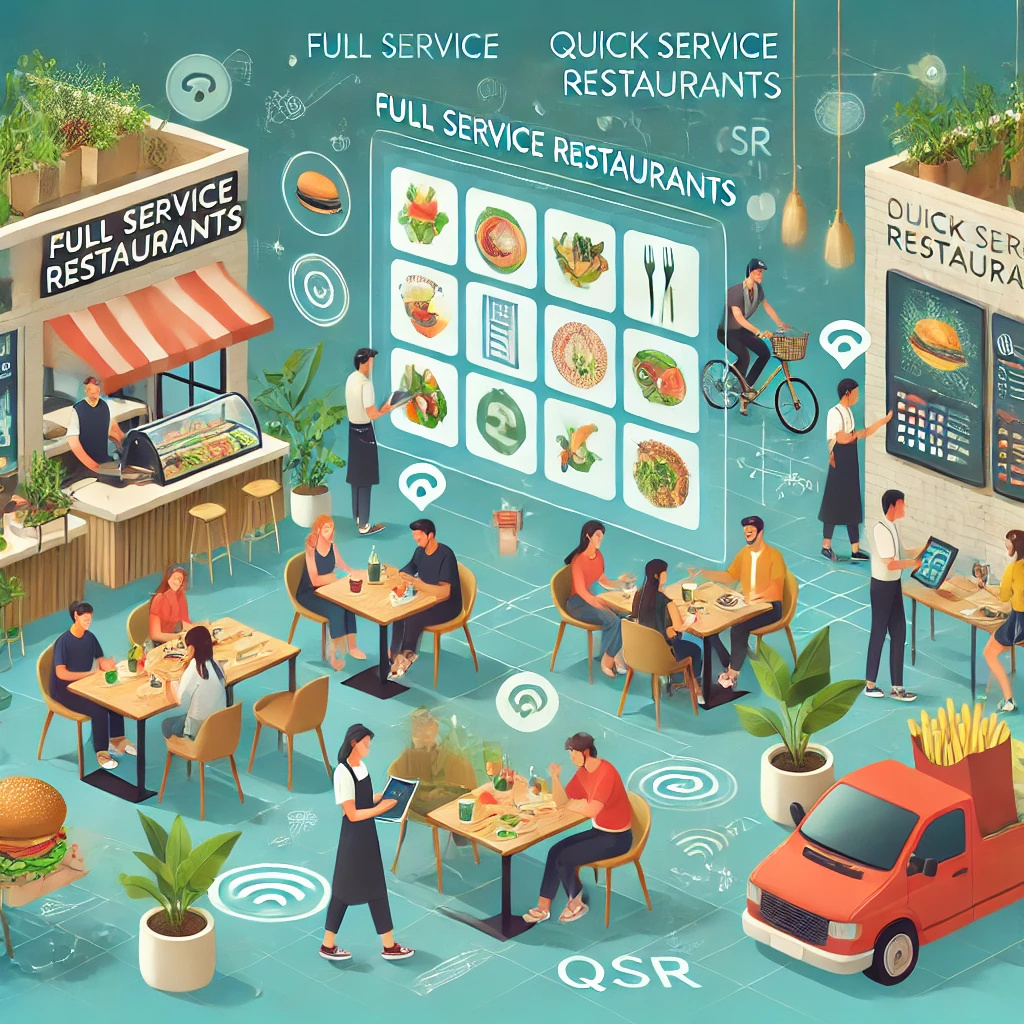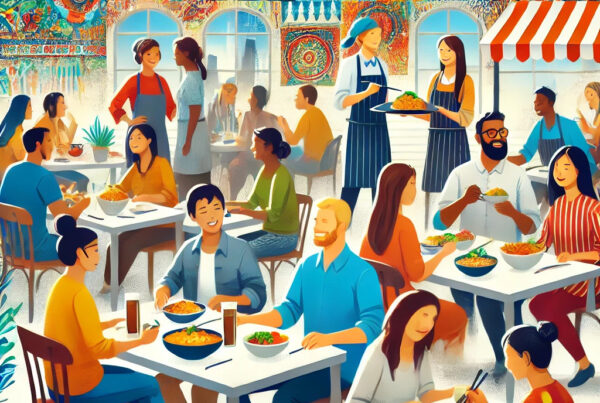Consumer Trends in the FSR & QSR Industry: A 2024 Perspective
The restaurant industry is ever-evolving, and the Full-Service Restaurant (FSR) and Quick-Service Restaurant (QSR) sectors are no exception. In 2024, shifting consumer preferences, technological advancements, and societal changes are redefining how FSR and QSR establishments operate. For restaurateurs and industry stakeholders, staying ahead of these trends is critical for success. Let’s dive into the latest consumer trends shaping the FSR and QSR landscape.
1. Digital Convenience: A Must-Have
The rise of technology continues to revolutionize the dining experience. Consumers now expect seamless digital interactions at both FSR and QSR establishments, and restaurants that fail to adapt risk losing business. Key aspects of this trend include:
- Mobile Ordering: Apps and websites that allow customers to place orders quickly are no longer optional. FSRs are adopting pre-ordering options for dine-in guests, while QSRs are optimizing mobile platforms for speed.
- Contactless Payments: From QR codes to mobile wallets, contactless payments have become standard, enhancing both convenience and hygiene.
- Digital Loyalty Programs: Restaurants are leveraging apps to reward repeat customers, offering points, discounts, and personalized deals.
2. Sustainability Takes Center Stage
Sustainability is no longer a niche concern—it’s a mainstream expectation. Consumers are increasingly prioritizing eco-friendly practices, influencing their choice of where to dine. Examples of sustainable practices include:
- Eco-Friendly Packaging: QSRs are adopting biodegradable and recyclable packaging to reduce waste.
- Sustainable Sourcing: FSRs are highlighting locally sourced and organic ingredients on their menus.
- Carbon Footprint Transparency: Some restaurants are disclosing the environmental impact of their menu items, appealing to environmentally conscious diners.
3. Health-Conscious Menus
The demand for healthier options continues to grow across all demographics. Restaurants are meeting this demand by:
- Expanding Plant-Based Options: From Impossible Burgers at QSRs to gourmet vegan dishes at FSRs, plant-based eating is on the rise.
- Highlighting Nutritional Information: Clear labeling of calories, allergens, and ingredients helps consumers make informed decisions.
- Offering Functional Foods: Ingredients with health benefits, such as turmeric, probiotics, and adaptogens, are gaining traction in both QSRs and FSRs.
4. The Rise of Personalization
Consumers increasingly expect personalized dining experiences, whether they’re ordering from a fast-food drive-thru or sitting down for a multi-course meal. Restaurants are achieving personalization through:
- Data-Driven Insights: Leveraging customer data to recommend menu items based on preferences.
- Customizable Menus: Allowing diners to tailor their orders to suit dietary restrictions or flavor preferences.
- Geotargeted Marketing: Sending promotions and deals to customers based on their location.
5. Enhanced In-Store Experiences
While convenience and delivery are important, in-store dining remains a significant part of the restaurant experience. To entice customers to visit, FSRs and QSRs are focusing on:
- Unique Ambiance: From themed decor to live music, restaurants are creating memorable atmospheres.
- Interactive Technology: Tabletop tablets, self-service kiosks, and augmented reality experiences are enhancing the dining experience.
- Community Engagement: Hosting events, such as trivia nights or fundraisers, fosters a sense of community.
6. The Delivery and Takeout Boom
The pandemic permanently shifted consumer behavior toward delivery and takeout. Even as dining rooms reopen, the convenience of off-premise dining remains a top priority. Key trends include:
- Ghost Kitchens: These delivery-only concepts are thriving in the QSR space.
- Subscription Models: Some FSRs are offering meal plans for regular customers, ensuring consistent revenue streams.
- Enhanced Packaging: To-go orders now come in packaging designed to maintain food quality and temperature.
7. Diverse Flavors and Cuisines
Global flavors are dominating menus as consumers seek out new and exciting culinary experiences. Trends in diverse cuisine include:
- Fusion Dishes: Combining elements from different cuisines to create innovative dishes.
- Regional Specialties: Highlighting hyper-local or regional foods that tell a story.
- Limited-Time Offers: Featuring seasonal or culturally significant dishes to generate buzz.
8. Emphasis on Transparency and Ethics
Modern diners value transparency and ethical practices more than ever. Restaurants are responding by:
- Open Kitchens: Allowing customers to see food preparation fosters trust and excitement.
- Ethical Labor Practices: Highlighting fair wages and safe working conditions appeals to socially conscious consumers.
- Honest Marketing: Avoiding greenwashing and providing accurate claims about sustainability or sourcing.
9. Technology Integration Beyond the Table
Tech-savvy consumers expect a smooth experience before, during, and after their visit. Restaurants are adopting technology for:
- Inventory Management: Reducing waste and ensuring menu consistency.
- AI-Powered Analytics: Understanding customer behavior to refine operations and marketing.
- Smart Kitchen Equipment: Enhancing efficiency and food quality with connected appliances.
10. Catering to Younger Generations
Gen Z and Millennials continue to shape consumer trends with their preferences for:
- Social Media-Worthy Moments: Instagrammable dishes and decor remain powerful marketing tools.
- Brand Values Alignment: Choosing restaurants that reflect their personal values, such as sustainability or inclusivity.
- Interactive Engagement: Loyalty programs with gamified elements or engaging social media campaigns.
Implications for FSR and QSR Operators
The evolving consumer trends present both opportunities and challenges for FSRs and QSRs. To thrive in this competitive landscape, operators should:
- Invest in Technology: From mobile ordering systems to kitchen automation, tech adoption is essential.
- Prioritize Customer Experience: Ensure every touchpoint, from online ordering to in-store dining, exceeds expectations.
- Stay Agile: Consumer preferences can shift quickly, so adaptability is crucial for long-term success.
- Focus on Branding: A strong, authentic brand that aligns with current trends will attract loyal customers.
The FSR and QSR industries are at an exciting crossroads, driven by innovative trends and shifting consumer demands. By understanding and embracing these trends, restaurants can position themselves for growth and relevance in 2024 and beyond. Whether it’s through digital transformation, sustainability efforts, or creating unforgettable dining experiences, the future of dining lies in the ability to adapt and innovate.


 More Feature News
More Feature News







